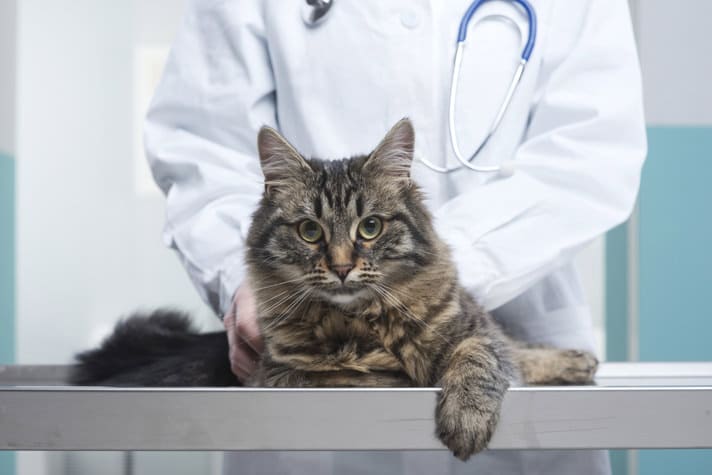The day is finally here — you took your kitten in for vaccines, and the veterinarian told you that it was time to make an appointment to have her spayed. You like and trust your veterinarian, but you have so many questions swirling through your mind. She’s so small, you think. Perhaps we should wait just a few more months. She won’t be going outside, so there is no need to have her spayed. Yet the recommendation to schedule the spay as soon as possible still circles through your mind over and over again. So, why do veterinarians recommend such a major surgery for such a young animal, and what can you do to make the process as smooth as possible? Here’s everything you need to know.
Why Spay or Neuter Now?
In the United States and most of North America, spaying involves the removal of both the ovaries and the uterus; and the surgery for the males–neutering–involves removing the testicle and associated tissue. Most people are familiar with the fact that this makes the cat unable to reproduce, thanks in part to all of the media attention to “Help the pet over-population problem–spay or neuter your cat.” It is true: Once the animal has been spayed, she is then unable to get pregnant. But did you know that spaying or neutering your kitten also helps to prevent both health and behavioral problems?
When the reproductive organs are removed, the kitten no longer is able to produce the hormones associated with a heat cycle. This means that the crazy behavior female cats go through when they cycle no longer happens: the howling, trying to escape the house in an attempt to look for male cats, “treading” their back feet and “flagging” their tail. The males no longer howl constantly or urinate in the house, and they are less likely to rip out window screens in attempts to escape.
There are also some major health benefits. The likelihood your cat will develop breast cancer is significantly reduced (and almost eliminated) if she is spayed before her first heat cycle; and cancers of the uterus and ovaries are also prevented. The risk of her developing a uterine infection (called a pyometra), which can be fatal, is essentially entirely eliminated. For the males, the risk of testicular neoplasia is completely eliminated.
Any procedure that greatly reduces or eliminates the likelihood of cancer and fatal diseases is a good one in anyone’s book. These are particularly accentuated in the kitten, who hasn’t yet experienced a heat cycle.
From a veterinarian’s perspective, I hate to treat and address problems later in life that could have been completely prevented. This reminds me of a current patient of mine named Jasmine. Jasmine came to me at the age of 12 when her owners noticed a lump on her belly. The lump had been there for quite awhile, and seemed to be getting bigger. It was right next to the nipple, and I was concerned that it might be breast cancer. In talking to the owners, I found out that they had adopted Jasmine when she was 18 months old and still hadn’t been spayed. In fact, she was in heat when they took her home for the first time. Having her spayed was top of their priority list, and once Jasmine recovered from her spay surgery, her owners thought that was the end of the story. Read on, and we’ll come back to this later.
Making an Appointment
So, after considering all of the benefits, you decide to schedule the appointment to have your kitten spayed. Here’s what you need to ask about when you schedule the appointment.
1. Does your hospital recommend/require pre-anesthetic blood work for my kitty?
This tests your kitten’s liver, kidneys and bone marrow to see if they are functioning well enough to safely handle the anesthetic. Some veterinarians also check how well the blood is clotting. These tests are often optional, but can screen for issues, such as birth defects, which may complicate either the surgery or the recovery. All kittens should be tested for Feline Leukemia and Feline Immunodeficiency Viruses, which they can be exposed to even before birth and serve to weaken their immune system. Many veterinarians will do this at one of the kitten vaccine visits, but sometimes it is also done the day of the procedure.
2. Will she/he receive an IV catheter as a safety mechanism?
Many veterinarians recommend or require an IV catheter for the spay surgery and, less commonly, for the neutering. An IV catheter for a cat is very much the same as an IV line for a human in that it allows the doctor to give medications directly into the blood stream. This can be lifesaving if there are any concerns while the cat is sedated. It’s particularly valuable for the very small patient, who may experience rapid changes in blood pressure and condition while under anesthesia. If your kitten has an IV catheter, there will be a shaved area — usually on one of the front paws — when she comes home. Never fear, the fur grows back in a few weeks, but it is a reminder that your kitty had a little extra margin of safety while she was sleeping.
3. How many days’ worth of pain medication will I be giving afterwards?
Pain medications are an important factor to ask about. No one wants kitty to hurt, and this is, indeed, a major surgery for your pet. Most modern anesthetic protocols are what are called “balanced” — meaning that the veterinarian uses tiny doses of multiple drugs for your animal. This helps to avoid over-dosing of any one drug and causing side effects. Basically, the cat is given a number of different medications in mini-doses that work together to keep your kitty comfortable. Many cats will get three or four different pain relieving medications as part of the anesthetic protocol, and all should bring home a few days worth of pain medication. (Normal is three to five days). Although kittens in particular bounce back very quickly from surgery, it doesn’t mean they don’t feel pain — just that they are too silly to acknowledge it!
Time for Surgery
Surgery day is here, and you are dropping your kitten off at the hospital. Per your vet’s instructions, you didn’t give kitty her breakfast this morning, so you are feeling extra guilty. But what happens after you hand the carrier over to the receptionist?
First, the veterinary technician will probably do some basic tests — check her heart rate, temperature and respiratory rate, as well as double-checking the sex! If you have chosen to have blood tests done, these will be taken at this point in time. The veterinarian will also examine your kitten to be sure everything appears well.
Once all the tests are in, your cat is sedated with an injection and is allowed to fall asleep in a quiet area. At this point, if an IV catheter will be used, it is placed in the front leg, allowing the veterinary team to give IV fluids and additional medications, if needed. If your kitten is female, she’ll have an endotracheal tube placed into her windpipe to help her breathe an anesthetic gas and oxygen, keeping her asleep, safe and comfortable for the procedure. Since the procedure is quicker in the males, most veterinarians don’t use an endotracheal tube.
Once kitty is asleep, the veterinary team will clip a window of fur and sterilize the area. For the females, the veterinarian will make a 1- to 2-inch incision near the belly button, through which the entire surgery takes place. The males will have two tiny incisions right over the scrotum through which the testicles are removed.
Recovering from Spaying or Neutering
Although your kitty may come home with sutures, many veterinarians are now using “absorbable” sutures under the skin, which are not visible, and will dissolve within a few weeks to a few months after surgery. It is very important, however, to check the incision every day for the first two weeks after the procedure to look for any swelling, redness, discharge or pain. All of these are abnormal and should prompt a recheck with your veterinarian.
Also be sure to give all medications your veterinarian sends home — even though kitty appears to be feeling much better. There is a reason these are sent home, and it is much easier to prevent a problem (such as pain!) than to treat it.
And, as easy as that, your little 3-pound bouncing baby is now altered — and the worry of breast cancer, uterine infections, testicular or ovarian cancer and behavioral issues associated with hormones can be swept aside as you watch your cat grow up.
So, what happened to little Jasmine, the kitty from earlier with the lumps in her breast? As it turns out, she did have breast cancer. We did a radical mastectomy, sent the tissue to the pathologist for analysis, and determined that she had the type of cancer most likely associated with hormone stimulation. Because she went through several heat cycles before she was spayed, Jasmine was in a high-risk category for cancer. Fortunately, we were able to remove it before there was metastasis, and to date, three months after surgery, Jasmine is still doing well.
Perhaps the biggest benefit to pediatric spays and neuters is that we are able to step in before the body has been primed with hormones associated with heat cycles and puberty. This increases our chances to prevent cancers and behavioral problems. Our pediatric patients usually recover very quickly, and never look back as they go on to lead healthy, happy lives!
Featured Image: morozv/Shutterstock
By: Dr. Sandra Mitchell
Share:









